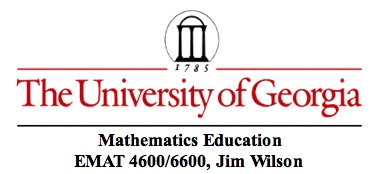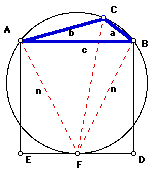

Suppose that triangle ABC has integral side lengths a = BC, b = CA, c = AB and side AB is the longest side. Construct a square ABDE on the side of AB remote from C. Suppose furthermore that side DE of the square ABDE is tangent to the circumcircle of triangle ABC.
 Strategy: Finding an expression for c in terms
of a and b can ignore the requirement for integer
values. Once we have an expression for (1) we can use it to search
for integer values of a, b, and c.
Strategy: Finding an expression for c in terms
of a and b can ignore the requirement for integer
values. Once we have an expression for (1) we can use it to search
for integer values of a, b, and c.
Let the lengths of the sides AF and BF be on length n. Can you solve for n in terms of c?